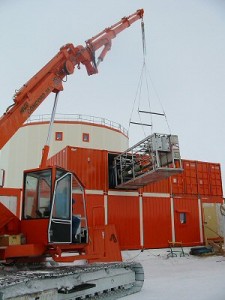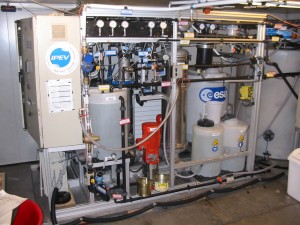During their months in isolation the Concordia crew will be using recycled water processed from a unit developed with the polar institutes IPEV and PNRA and based on knowledge gained by ESA’s MELiSSA project. The project is a great of example of cooperation between Concordia and ESA. ESA’s Brigitte Lamaze explains all:
MELiSSA has been working for over 20 years to create self-sustaining eco-systems to support life indefinitely in a closed environment. Water processing, whereby all water is captured and purified to be consumed again, is part of the technologies needed to achieve this goal.
In an average day a human being or astronaut will, metabolically, consume about 1 kg of oxygen, 1 kg of food and 3 kg of water, so water recycling is an important aspect for planning long-term expeditions. The more we recycle, less consumables are need to be transported on a mission, be it to the International Space Station or Concordia, cutting costs and freeing transport for scientific experiments and equipment.
First we need to look a bit closer at waste water. We distinguish between three types of waste water: ‘grey water’ is runoff from washing such as when taking a shower or washing vegetables and hands. Next comes ‘yellow water’ with is what we call urine. Lastly the so-called ‘black water’ is aptly named as it comes from organic wastes and faecal matter. An average human being will produce between 2 and 20 litres of grey water (depending on the length of their shower), 1.5 litres of yellow water and 0.2 litres of black water every day.
As humans produce mostly grey water, ESA has focussed on grey water recycling since the 1990’s. We created a working prototype and were looking to test the system for robustness in realistic conditions. Concordia is an ideal place to test a water recycling system as it is a realistic simulation for some aspects of human spaceflight and can be tested for a longer period of time.
We designed a system that fits in a standard shipping container and was transported to Concordia over land on a Raid trail in 2005. Since then it has operated without significant problems.
The system uses a three-step ceramic honeycomb with holes of only around one nanometre. Ceramics are very resistant to chemicals but are breakable so getting the filters to Concordia was hair-raising. Once installed they are very reliable and have never been replaced in the seven years they have been working.
The next step in the filtration uses two reverse-osmosis filters to spit out clean water. Thin membranes are rolled up to increase surface contact with the water and increase the speed at which the water filters through the membranes. The membranes have been replaced twice since the unit has been operational.
Some precautions are necessary to use the system such as separating water intake and using soap that has been tested for use with the water recycler.
The unit has proven to be very robust and has even coped with accidents such as spills of corrosive chemicals in the normal drains.
All Concordia crew receive basic training about the system and the unit was given a complete check in 2010. This project helped ESA test its prototype and supplied data based on real-life situations while helping Concordia research station cut down on costs and keep in line with the Antarctica treaty that states no waste must be left behind in Antarctica.







Discussion: one comment
nice